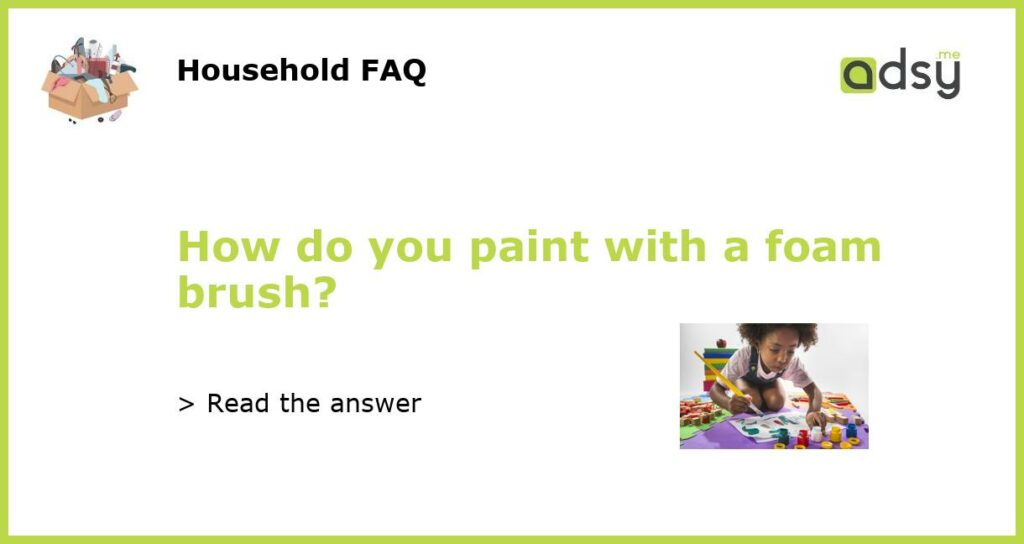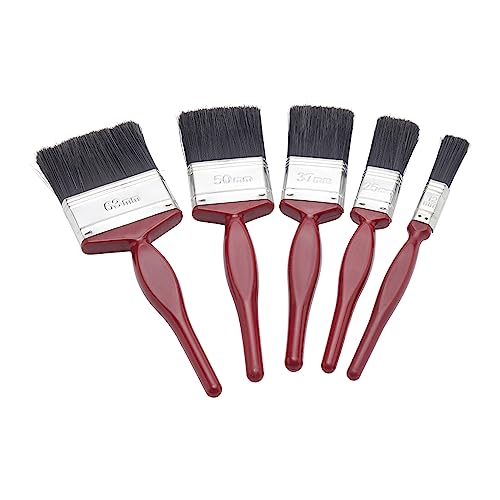Benefits of using a foam brush for painting
When it comes to painting, there are various tools and techniques that can be used. One popular choice is the foam brush. Foam brushes are made of foam bristles that are attached to a wooden or plastic handle. They are commonly used for delicate or intricate painting tasks, as well as for applying stains, varnishes, and finishes. Here are some of the benefits of using a foam brush for painting:
– Smooth application: Foam brushes are known for providing a smooth finish. The foam bristles hold and distribute paint evenly, resulting in a uniform and professional-looking surface.
– No brush marks: Unlike traditional brushes, foam brushes leave minimal to no visible brush marks on the painted surface. This is because the foam bristles have a smooth texture and are designed to blend the paint smoothly.
– Easy to clean: Foam brushes are easy to clean compared to other types of brushes. They can be rinsed with water or cleaned with a mild soap solution. This makes them a convenient choice for both amateur and professional painters.
– Versatile: Foam brushes can be used with a variety of paints, including latex, acrylic, and oil-based paints. They are also suitable for applying different types of finishes, such as stains, varnishes, and polyurethane coatings.
– Cost-effective: Foam brushes are generally affordable and readily available at most hardware and paint stores. They can be used multiple times if properly cleaned and maintained, making them a cost-effective option for painting projects.
Preparing the foam brush for painting
Before using a foam brush for painting, it is important to prepare it properly to ensure optimal paint application. Follow these steps to prepare your foam brush:
– Rinse the brush: If the foam brush is brand new, rinse it with water to remove any manufacturing residue or dust. This will help prevent any unwanted particles from mixing with the paint and affecting the final finish.
– Prime the brush: If you are using an oil-based paint, it is recommended to prime the foam brush before use. This can be done by dipping the brush into the paint thinner or mineral spirits, then squeezing out any excess liquid. This step helps prevent the paint from soaking into the foam and prolongs the life of the brush.
– Dampen the brush: Before using a foam brush, dampen it slightly with water. This helps the paint flow smoothly and evenly onto the surface. Do not soak the brush, as excess water can dilute the paint and affect its adhesion.
– Use a paint tray: Pour a small amount of paint into a paint tray or a disposable container. This will make it easier to load the foam brush with paint and control the amount of paint applied to the surface.
Techniques for painting with a foam brush
When painting with a foam brush, there are several techniques that can be employed to achieve the desired results. Here are some tips to keep in mind:
– Apply light pressure: Foam brushes are best used with light pressure. Applying too much pressure can cause the foam bristles to bend or flatten, resulting in an uneven application of paint.
– Use smooth, even strokes: Use smooth and even strokes when applying the paint with a foam brush. This helps ensure uniform coverage and minimizes the visibility of brush marks.
– Work in small sections: To maintain control over the paint application, it is recommended to work in small sections. Start at one corner or edge of the surface and gradually work your way across, ensuring each section is fully covered before moving on.
– Avoid overloading the brush: To prevent dripping and excessive paint buildup, avoid overloading the foam brush with paint. Dip the brush into the paint, then tap it lightly against the side of the paint tray to remove any excess paint.
– Blend wet edges: Foam brushes are excellent for blending wet edges while painting. This can be particularly useful when working with large surfaces or when applying multiple coats of paint. To blend the wet edges, lightly feather the brush strokes along the edge of the painted area.
Cleaning and maintaining foam brushes
Proper cleaning and maintenance of foam brushes are essential to prolong their lifespan and ensure optimal performance. Here’s how to clean and maintain your foam brushes:
– Immediately after use, rinse the foam brush with water or the appropriate cleaning solution, depending on the type of paint or finish used.
– Gently squeeze out any excess paint or cleaning solution from the brush.
– For oil-based paints or finishes, soak the brush in an appropriate solvent, such as paint thinner or mineral spirits, for a few minutes to dissolve any residual paint.
– Rinse the brush thoroughly with water to remove any remaining paint or solvent.
– Pat dry the brush with a clean cloth or paper towel to remove excess moisture.
– Store the foam brush in a dry and upright position to maintain its shape and prevent deformation.
Alternatives to foam brushes for painting
While foam brushes are suitable for various painting tasks, they may not be the ideal choice for every situation. Here are some alternatives to foam brushes:
– Synthetic paint brushes: Synthetic paint brushes are a popular choice for both amateur and professional painters. They come in different sizes and shapes, making them suitable for different painting techniques and surfaces. Synthetic brushes offer excellent paint control and can be used with various types of paints and finishes.
– Natural bristle brushes: Natural bristle brushes, such as those made from hog hair, are commonly used for oil-based paints and finishes. They are known for their ability to hold and distribute paint effectively, resulting in a smooth and even finish. Natural bristle brushes work best on surfaces that require a more textured or traditional look.
– Roller brushes: Roller brushes are often used for painting large or flat surfaces, such as walls or ceilings. They can cover a larger area in less time compared to brushes, making them efficient for certain painting projects. Roller brushes come in different thicknesses and textures to create various finishes, from smooth to textured.
– Sprayers: Paint sprayers are a high-speed and efficient option for painting large surfaces or for achieving a smooth, flawless finish. They are commonly used in professional painting applications but can also be used by experienced DIYers.
When choosing a painting tool, consider the specific requirements of your project, such as the type of surface, desired finish, and the type of paint or finish being used.






